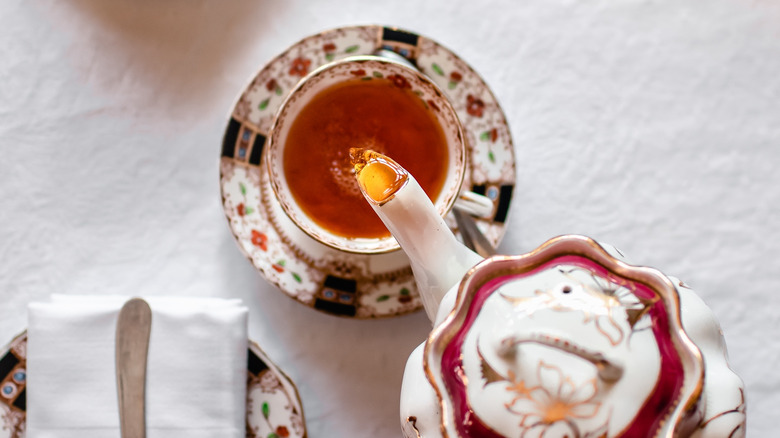Irish Breakfast Tea Vs English: What's The Difference?
While the history of tea's origin is riddled with legend, it's important to understand the differences between tea varieties. While black tea may seem like it is all the same, there are subtle flavor distinctions in the tea's profile due to the origin of the crop — the geography of the region, the climate, even the soil, and the way the tea is farmed. Then, you need to take into account the different combinations of the blends, and the percentages of each blend present in the tea.
Irish and English breakfast teas differ most in the blend that composes each. English breakfast teas are typically comprised of Assam and Kenyan blends — Irish varieties are more diverse, ranging from Assam and Kenyan to Ceylon (Lyons, we're looking at you), Rwandan (featured in the famed Barry's), and more.
Irish breakfast tea tends to have a heavier, deeper malt flavor, and the English variety is slightly malty with a tad more floral and delicate. However, the largest difference boils down to caffeine. Irish tea edges out English tea in caffeine levels (though the actual amount can vary based on how long the tea steeps).
Of course, no matter which type you buy, every company's blend varies. Therefore, the exact taste directly relies on the brand you purchase, how long you steep it, what you add to it — and even the temperature of the water can impact your tea. Yes — boiling water is actually ruining your tea, so to get the most out of your cup, let the kettle sit a moment before you pour.
More on Irish breakfast tea
Irish breakfast tea has a much more powerful taste, often described as malty and dark. The many different blends create a bold and robust flavor and a distinctly reddish tint. Irish beer, like Guinness stout, is strong and packed with deep maltiness; it's safe to say Irish tea follows the same lead. Fun fact: the Irish drink almost (on average) six cups of tea daily — more than the British.
Not only will you get a red tint and a stronger brew, but the tea also provides a full-bodied, thicker mouthfeel. Additionally, since it's much more flavorful, it's not unheard of to add a generous portion of milk to your cup alongside your choice of sweetener. Choose sugar for simple sweetness or honey to impart a bit of a sweet, floral note.
Of course, it's worth mentioning that this daring brew pairs perfectly with a hearty, classic Irish breakfast comprised of fried eggs, back bacon, sausage, white pudding (different from a full English, which has black pudding), soda bread, mushrooms, and pan-fried tomatoes for an unforgettably robust start to the day.
The details on English breakfast tea
When you first hear English breakfast tea, you may think of high tea, but high tea is a hearty meal you have after work — much like dinner. One essential feature of this classic meal is a lovely cup of tea.
Most often, English breakfast tea blends feature Assam and Kenyan varieties, very occasionally Ceylon. However, just like with the Irish kind, every brand uses different percentages and blends, making a vaguely different flavor and strength.
Most English breakfast teas produce a warm, comforting cup that's less robust and more floral. Additionally, it has a smooth mouthfeel, making a drink that goes down easy. Taste-wise, it ranges from vaguely smoky to lightly malted and richly balanced.
Enjoy a cup with milk and sugar and a few tea sandwiches from Fortnum and Mason for the ultimate experience. Or, let cultural worlds collide by pairing your deliciously warm cup of British tea with a slice of French yogurt cake. The sweet and moist cake complements the tea's malty, somewhat bitter, notes.



